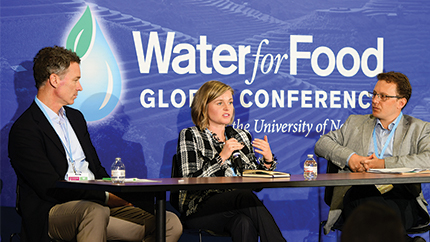Note: This a featured session summary from the Proceedings of the 2019 Water for Food Global Conference that took place April 29-30, 2019 in Lincoln, Nebraska, USA.
This conference session brought together water thought leaders to provide a variety of perspectives on the value of water and insights to help develop innovative solutions for water scarcity. Session speakers offered insights from nonprofit, business, and academic perspectives. Nick Brozović, director of policy at DWFI, kicked off the session by touching on the rising interest in using incentive-based management tools such as water markets to reallocate water between different users and sustain and enhance environmental flows.
Tom Iseman, director of water scarcity and markets for the Global Freshwater Program at The Nature Conservancy, explained how working with the agricultural sector to provide food and water sustainability is a key part of the global organization’s work to protect land, water and life. One-third of the world is currently facing water scarcity impacting humans and the natural environment. Because three-quarters of all irrigated land is in danger of losing productivity, he said, sustainably managing water is more important than ever.
Iseman emphasized The Nature Conservancy’s four strategic pillars for achieving the goal of a resilient water supply in the Northern United States: 1) Water Markets, 2) Investment in Water Innovation and 3) Infrastructure, Agricultural Supply Chain, and 4) Water Policy and Governance. Case studies show well-defined water rights can help balance the needs of farmers and communities. “Think broadly. It is not just about markets. It is about users, value and presence,” said Iseman.

Richael Young, cofounder and CEO of Mammoth Trading, focused her presentation on the potential for using water markets as a tool to value water and achieve multiple objectives for diverse water users. Young stressed the need to understand whether a local region is ready to implement water transfer systems effectively – or not. There is growing recognition that water markets have the potential to reduce the impact of regulations, monetize conservation and increase the value of water. As a result, there has been an increasing interest in how to scale water markets to increase their impact. However, no comprehensive tools currently exist to assess the market readiness of a region, including evaluating legal, biophysical, economic and administrative considerations.
Young is developing a Water Market Transfer Toolkit with DWFI, supported by USDA, to provide key metrics to determine market readiness in any region. Metrics gathered include: severity of water risk, legal readiness, administrative readiness, heterogeneity in values of water, and infrastructure readiness. Each metric is scored as low, medium or high. After considering scores and other qualitative factors, stakeholders can decide whether water markets are an appropriate management tool in a given region. The toolkit was demonstrated using information for some of the newly-formed California Groundwater Sustainability Agencies.
Dustin Garrick, associate professor and co-director of the Smith School of Enterprise and the Environment at the University of Oxford, presented a global view on conflicting water values as they impact allocation. He said conflicts generally arise as stakeholders try to balance water between human and environmental needs, between agriculture and growing cities, and between different jurisdictions across borders. Garrick shared several case studies to illustrate his points. “We need to not just focus on the successful models, but also what has struggled,” he said, “and how to learn from those challenges.”
In the city of Monterrey, Mexico, the increasing population caused the government to extend the city boundary to make the city a part of the urban-rural system. As a result, over time, water management improved between urban areas and downstream farmers.
An example from Melbourne, Australia, showed increased water recovery when water was reallocated through irrigation modernization. One Australian project showed how important it is to prepare for crises across boundaries, so areas are ready with financing, data, technical analyses, engagement and a plan when they occur. A case study from Kenya showed how embracing informality of water supply is sometimes a pragmatic way to achieve water security.
Garrick emphasized that the processes of developing water markets and solving water conflicts often take a long period of time. He concluded with the need to explore scalable solutions to freshwater scarcity by providing a variety of incentives for sustainable water use, including water markets, incentives for conservation, and new policy and planning approaches.
In a lively discussion with the speakers, audience questions included asking for practical advice for water managers, addressing the role of trust in building formal or informal institutions, how the water profession could be coupled better with public health, and who should be responsible for incentivizing water transfers.
The key takeaway messages remind us to inform all users about the full range of threats and opportunities related to water scarcity. It’s important to not just talk about markets, but to keep working toward a set of better incentives and address misconceptions about markets and water allocation. For example, consumers don’t always trust public utilities, so informal markets can be helpful in filling the gap and should not always be seen as threats, advised Garrick. The federal government can help facilitate conversations, demonstrate commitment and show action by investing money in infrastructure.
It’s also important to remember there is no single silver bullet approach; there are many lessons to be learned from one another locally, nationally and globally. As Young put it, “Don’t do it by yourself. There is already a wealth of information on water management and we need to learn from lessons of success and failure and leapfrog forward.”
View a full video recording of this session on YouTube.
Speakers:
- Dustin Garrick, Associate Professor and Co-Director of the Smith School of Enterprise and the Environment at the University of Oxford
- Tom Iseman, Director of Water Scarcity and Markets Strategy, The Nature Conservancy, Global Program
- Richael Young, Co-Founder and CEO, Mammoth Trading

